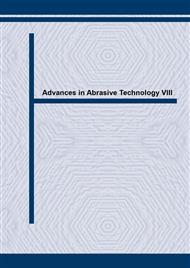p.109
p.115
p.121
p.127
p.133
p.139
p.145
p.151
p.157
Surface Quality Improvement of Aspheric Pressing Mould Using Parallel Grinding Method
Abstract:
It is a cost-effective technology to obtain aspheric optics made from optical glass and other brittle materials using pressing mould. The optical quality of molded optics is determined mostly by the surface quality of the mould, which means poor mould surface with lots of cutter marks will result in adhesion phenomena and error replication between the optics and mould. [1] In this article, a chatter model about parallel grinding system was presented, and the reasons of chatter induced by velocity feed back was analyzed and simulated. By using parallel grinding system integrated ELID technology, and wheel with greater cross-section radius in rough grinding and constant grinding velocity in fine grinding, the amplitude of cutter marks in the surface of mould was minimized and the quality of the mould surface was improved.
Info:
Periodical:
Pages:
133-138
Citation:
Online since:
August 2005
Authors:
Price:
Сopyright:
© 2005 Trans Tech Publications Ltd. All Rights Reserved
Share:
Citation:


